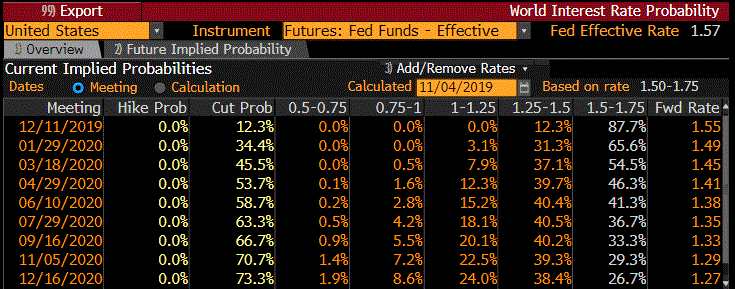
Interest Rate Outlook: Federal Reserve Cuts Rates Once Again
In a move that was widely expected, the Federal Reserve cut rates last Wednesday by 25 basis points to the 1.50% to 1.75% range. Seven officials voted for the cut, and two (Esther George and Eric Rosengren) dissented again in favor of no change in monetary policy. Because the rate reduction had been anticipated, the markets were mainly focused on changes to the accompanying statement, most notably where the FOMC removed its previous pledge to “act as appropriate to sustain the expansion”. Many economists interpreted this action as a signal the Fed will hold off on further easing for at least the remainder of the year. During the post-meeting press conference, Chair Jerome Powell again characterized the FOMC’s latest decision as one intended to “provide some insurance against ongoing risks”, namely trade policy uncertainty, weakening global growth and worsening financial conditions. At the same time, he also acknowledged that trade tensions have eased somewhat with the possibility of a “Phase 1” agreement between the US and China, and odds have increased that the UK will be able to avoid a hard exit from the EU.
Initial Economic Data from October is Encouraging
The most recent Employment Report revealed that the economy added 128,000 jobs to payrolls in October, a figure that beat expectations for only 89,000 new jobs, and readings for August and September were also revised upwards by 95,000 in total. The unemployment rate increased from 3.5% to 3.6% following the entry of job-seekers into the market, a generally positive sign of confidence, while average hourly earnings rose by 0.1% to an annual rate of 3.0%. In a separate reading of factory activity, the Institute for Supply Management reported that its manufacturing index rose from 47.8 in September to 48.3 last month. The index dipped below 50 (the line separating expansion and contraction in the sector) for the first time in three years in August, sparking fears that recent high-profile trade disputes are beginning to impact domestic factory investment and production, but the slower decline in October manufacturing activity may point to resilience in the sector.
The Fed is Standing Pat … For Now
The Fed has signaled that it views the current level of interest rates as appropriate for the current economic environment and fed funds futures are largely in sync with this assessment. Futures contracts are currently pricing in a 12% chance of a cut at the FOMC’s final meeting of the year in December, odds which are slightly lower than those which were priced in prior to last week’s meeting. Futures don’t fully assume another 25 basis point cut until Q3 2020.

Source: Bloomberg
Our research is for personal, non-commercial use only. You may not copy, distribute or modify content contained on this Website without prior written authorization from Capital Advisors Group. By viewing this Website and/or downloading its content, you agree to the Terms of Use.
Please click here for disclosure information: Our research is for personal, non-commercial use only. You may not copy, distribute or modify content contained on this Website without prior written authorization from Capital Advisors Group. By viewing this Website and/or downloading its content, you agree to the Terms of Use & Privacy Policy.
